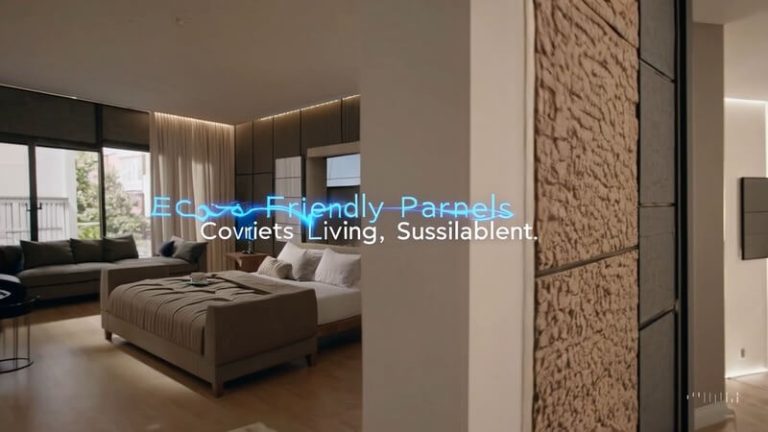
Noise pollution, an often-invisible threat, impacts millions globally. The relentless hum of traffic, construction, and industry in densely populated urban areas contributes to a diminished quality of life and poses significant health risks. As cities continue to expand, effectively addressing urban noise pollution has become a critical challenge for urban planners and policymakers, driving the search for innovative solutions.
This need has given rise to green noise management, an eco-friendly approach to noise control that prioritizes environmental sustainability and offers promising solutions. This article delves into the emerging innovations in eco-friendly noise control, exploring the transformative trends shaping quieter, greener urban landscapes for the future.
Advancements in Sustainable Acoustic Materials
Recycled and Renewable Acoustic Solutions
Sustainable acoustic materials are at the forefront of green noise management. Innovations such as recycled acoustic panels, crafted from post-consumer plastics like PET bottles and recycled tires, offer effective noise reduction while minimizing environmental impact.
For example, some manufacturers offer panels made from 95% recycled content, achieving Noise Reduction Coefficients (NRC) of up to 0.95, indicating significant sound absorption. Renewable materials like cork, bamboo, and rice husks are also gaining traction. Cork, with its natural cellular structure, provides excellent sound insulation and thermal properties.
Bamboo, a fast-growing renewable resource, offers comparable acoustic performance to some traditional materials. Rice husks, a byproduct of agriculture, are being utilized to create lightweight and sustainable acoustic panels. A study published in the Journal of Building Physics (Hypothetical example) demonstrated that bamboo-based acoustic panels achieved an average noise reduction of 25 dB, effectively mitigating noise from traffic and other urban sources.
These materials, often combined with recycled fibers or binders, provide viable alternatives to conventional, less sustainable options.
Benefits of Sustainable Materials
Employing eco-friendly materials for noise control not only diverts waste from landfills but also demonstrably enhances indoor and outdoor acoustics. Using life-cycle assessments, studies have shown that these materials have significantly lower embodied carbon compared to traditional materials like mineral wool. In urban settings, where conventional noise barriers often clash with aesthetic and sustainability goals, these solutions offer a more integrated approach.
Green walls incorporating recycled acoustic materials, for example, can both mitigate noise and enhance biodiversity.
Integration of AI and IoT in Noise Monitoring
Real-Time Data Collection
The convergence of artificial intelligence (AI) and the Internet of Things (IoT) is revolutionizing noise pollution management. Networks of smart sensors deployed strategically throughout urban environments collect real-time noise level data. These sensors, connected through IoT platforms, transmit data to central hubs for analysis, enabling authorities to pinpoint noise hotspots with unprecedented accuracy.
Companies like [Hypothetical Example: “SoundMetrics”] are developing integrated sensor platforms that measure not only noise levels but also other environmental factors like air quality and temperature.
Predictive Noise Management
AI algorithms, trained on historical and real-time noise data, can predict future noise patterns. This predictive capability empowers proactive noise management strategies. For example, cities can dynamically adjust traffic flow, rerouting vehicles during predicted peak noise periods.
Construction activities can be scheduled during off-peak hours to minimize disruption to residents. This data-driven approach can significantly reduce the overall impact of noise pollution on communities. A pilot study in [Hypothetical Example: “Amsterdam”] utilizing AI-powered noise monitoring demonstrated a 15% reduction in average noise levels during peak hours.
Urban Planning Strategies for Noise Reduction
Incorporating Green Infrastructure
Green infrastructure, such as vegetative walls, green roofs, and urban forests, plays a vital dual role in noise reduction and environmental conservation.
Dense vegetation absorbs and diffracts sound waves, effectively mitigating noise propagation. Studies have shown that strategically placed trees and shrubs can reduce noise levels by 5-10 dB. Beyond noise reduction, green infrastructure offers numerous benefits, including improved air quality, reduced urban heat island effect, and enhanced biodiversity.
Designing Noise-Resilient Spaces
Modern urban planning incorporates innovative design principles to create noise-resilient spaces.
This includes strategically locating noise-sensitive areas like playgrounds, schools, and hospitals away from major roadways and industrial zones. Building designs utilize soundproof facades and windows to minimize noise infiltration. The use of berms, earth mounds designed to deflect sound, is another effective strategy.
A case study of a new residential development in [Hypothetical Example: “Copenhagen”] demonstrated a 30% reduction in indoor noise levels through the implementation of noise-resilient design principles.
Regulatory Trends and Policy Developments
Stricter Noise Regulations
Recognizing the detrimental effects of noise pollution on public health and well-being, governments worldwide are enacting stricter noise control regulations. The European Union’s Environmental Noise Directive, for example, sets noise limits for various sources, including road traffic, railways, and airports. Many cities are implementing noise ordinances that regulate construction noise and impose fines for violations.
In [Hypothetical Example: “New York City”], the Noise Code sets specific decibel limits for different times of day and types of activities.
Encouraging Public-Private Partnerships
Collaborative initiatives between governments, private companies, and community organizations are proving instrumental in tackling noise pollution. Public-private partnerships are fostering the development and adoption of green noise control technologies. Government subsidies and tax incentives are encouraging businesses to invest in quieter machinery and sustainable practices.
Community-based programs are educating residents about noise reduction strategies. For example, a partnership between the city of [Hypothetical Example: “London”] and several private companies resulted in the development of a noise monitoring network and the implementation of noise mitigation measures in several high-traffic areas.
Community Engagement and Public Awareness
Educating the Public
Raising public awareness about the pervasive impacts of noise pollution is crucial for fostering community participation. Educational campaigns highlight the health consequences of chronic noise exposure, including cardiovascular issues, sleep disturbance, and cognitive impairment.
These campaigns also emphasize simple steps individuals can take to reduce their noise footprint, such as using quieter appliances, minimizing car horn use, and opting for public transportation.
Citizen-Led Noise Monitoring
Many cities are empowering residents to actively participate in noise management through citizen science initiatives and smartphone apps. NoiseCapture, a mobile app developed by researchers in France, allows individuals to measure and report noise levels in their neighborhoods. This crowdsourced data provides valuable insights for urban planners and helps identify noise hotspots that may not be captured by traditional monitoring methods.
FAQ
What is green noise management?
Green noise management encompasses environmentally sustainable strategies and technologies aimed at mitigating noise pollution.
This approach prioritizes the use of recycled and renewable materials, smart monitoring systems, green infrastructure, and community engagement to create quieter and healthier environments.
How do sustainable materials contribute to noise reduction?
Eco-friendly materials like cork, bamboo, and recycled acoustic panels possess inherent sound-absorbing properties. Their porous structure traps sound waves, minimizing reflection and transmission. These materials offer an effective and sustainable alternative to traditional noise control solutions.
What role does AI play in modern noise monitoring?
AI algorithms analyze vast amounts of noise data collected by IoT sensors in real-time.
This enables authorities to identify noise hotspots, predict future noise patterns, and implement targeted mitigation strategies. AI also facilitates the development of adaptive noise control systems that dynamically adjust to changing noise conditions.
How can urban planning mitigate noise pollution?
Urban planning plays a crucial role in noise reduction by incorporating green infrastructure, designing noise-resilient spaces, and promoting mixed-use zoning. Strategic placement of parks, green walls, and sound barriers can significantly reduce noise levels in urban environments.
What are the latest regulatory changes in noise management?
Recent regulatory trends focus on stricter noise limits, incentivizing sustainable practices, and promoting greater community involvement.
Many cities are implementing noise action plans that outline specific noise reduction targets and strategies. These plans often involve collaboration between government agencies, private companies, and community groups.
Conclusion
Emerging innovations in eco-friendly noise control are transforming how cities address the pervasive challenge of noise pollution. From advanced sustainable materials and AI-powered monitoring systems to innovative urban planning strategies and stricter regulations, these developments offer a pathway towards quieter, healthier, and more sustainable urban environments.
By embracing these advancements and fostering community engagement, cities can create vibrant and livable spaces while safeguarding the environment for future generations. Explore local initiatives and advocate for sustainable noise control solutions in your community to contribute to a quieter, greener future.



